<< Previous | Displaying results 2951-3000 of 6769 for "" | Next >>
Postwar photo of a church in the village of Chelmno. Jews were kept in this building en route to the Chelmno killing center. Chelmno, Poland, June 1945.
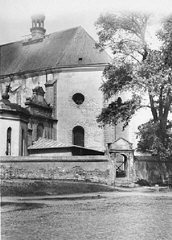
SS chief Heinrich Himmler leads an inspection of the Mauthausen concentration camp. Austria, April 27, 1941.
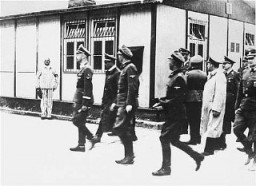
Prisoners at forced labor in the quarry of the Mauthausen concentration camp. Austria, date uncertain.
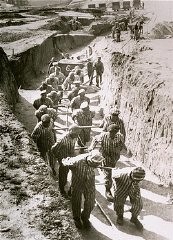
View of the Mauthausen concentration camp. This photograph was taken after the liberation of the camp. Austria, May 5-30, 1945.
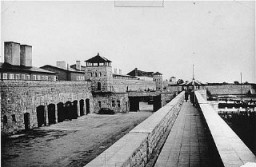
SS Colonel Franz Ziereis, commandant of the Mauthausen concentration camp in Austria.
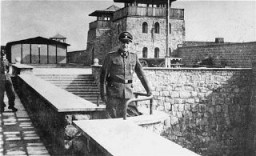
A Soviet inmate lies dead in the Mauthausen concentration camp quarry. Austria, between July 1941 and May 1945.
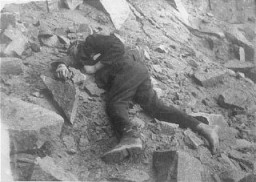
The Wiener Graben quarry of the Mauthausen concentration camp. Austria, photograph taken after the liberation of the camp.
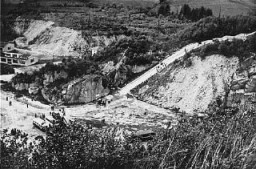
Soviet and Polish prisoners with disabilities stand in front of a tank of the 11th Armored Division, US Third Army. This photograph was taken at the Mauthausen concentration camp immediately after liberation. Austria, May 5–7, 1945.
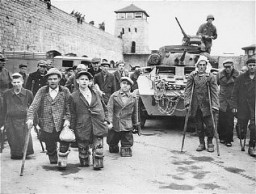
A US soldier with liberated prisoners of the Mauthausen concentration camp. Austria, May 1945.
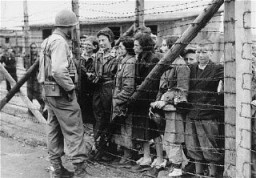
A US soldier looks at the Mauthausen crematorium during the liberation of the camp. Austria, May 1945.
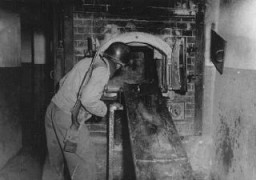
Emaciated survivors of the Mauthausen concentration camp soon after the liberation of the camp. Austria, May 1945.
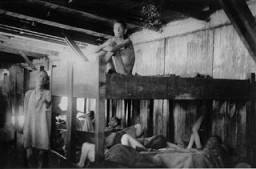
Emaciated survivors in barracks in the Mauthausen camp. Austria, May 1945, after liberation.
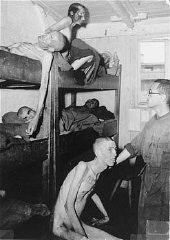
A pile of corpses at the Russian Camp (Hospital Camp) section of the Mauthausen concentration camp after liberation. Mauthausen, Austria, May 5-15, 1945.
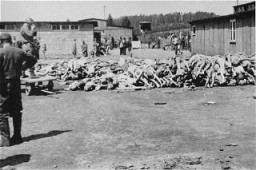
A mass grave at the Mauthausen concentration camp. Photograph taken after the liberation of the camp. Mauthausen, Austria, May 10–15, 1945.
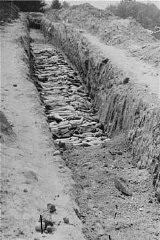
A 13-year-old orphan, a survivor of the Mauthausen concentration camp. Photograph taking following liberation of the camp. Austria, May 1945.
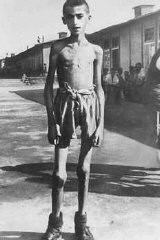
A view of the Buchenwald concentration camp after the liberation of the camp. Buchenwald, Germany, after April 11, 1945.
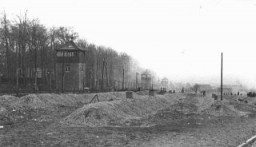
A view of barracks in the Buchenwald concentration camp. This photograph was taken after the liberation of the camp. Buchenwald, Germany, after April 11, 1945. Buchenwald, along with its subcamps, was one of the largest concentration camps established within the old German borders of 1937.
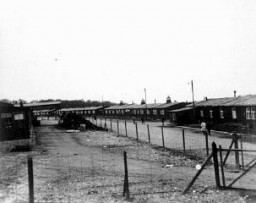
View of a guard tower and fence at the Buchenwald concentration camp. Germany, wartime.

Roll call for newly arrived prisoners, mostly Jews arrested during Kristallnacht (the "Night of Broken Glass" pogrom), at the Buchenwald concentration camp. Buchenwald, Germany, 1938.
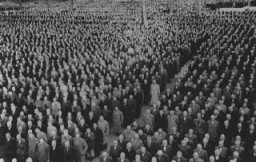
Prisoners during a roll call at the Buchenwald concentration camp. Their uniforms bear classifying triangular badges and identification numbers. Buchenwald, Germany, 1938–41.
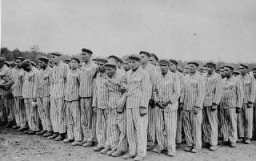
An SS officer standing in front of a newly constructed gallows in the forest near Buchenwald concentration camp. Buchenwald, Germany, April 1942.
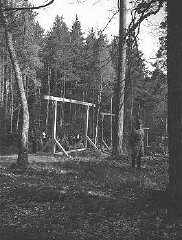
Execution of prisoners, most of them Jewish, in the forest near Buchenwald concentration camp. Germany, 1942 or 1943.
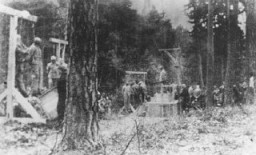
American soldiers and liberated prisoners at the main entrance of the Buchenwald concentration camp. Germany, May 1945.
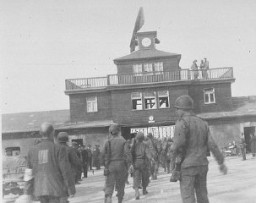
Wedding rings taken from prisoners. The rings were found near the Buchenwald concentration camp following liberation by US Army soldiers. Germany, May 1945.
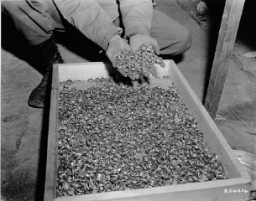
American troops, including African American soldiers from the Headquarters and Service Company of the 183rd Engineer Combat Battalion, 8th Corps, US 3rd Army, view corpses stacked behind the crematorium during an inspection tour of the Buchenwald concentration camp. Among those pictured is Leon Bass (the soldier third from left). Buchenwald, Germany, April 17, 1945.
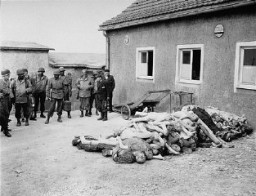
German civilians from the town of Nammering, under orders of American military authorities, dig graves for victims of a death march from the Buchenwald concentration camp. Germany, May 1945.
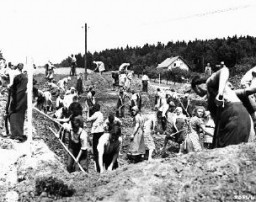
A pile of corpses in the Buchenwald concentration camp after liberation. Buchenwald, Germany, May 1945. Together with its many satellite camps, Buchenwald was one of the largest concentration camps established within the old German borders of 1937.
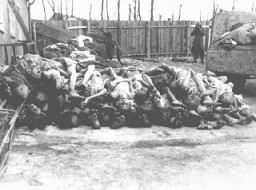
One of many piles of ashes and bones found by US soldiers at the Buchenwald concentration camp. Germany, April 14, 1945.
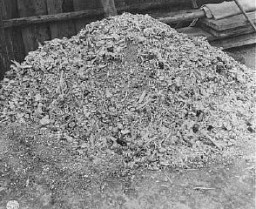
Survivors of the Buchenwald concentration camp gather around trucks carrying American troops. Germany, May 1945.
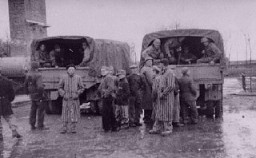
Adolf Hitler's authorization for the Euthanasia Program (Operation T4), signed in October 1939 but dated September 1, 1939.
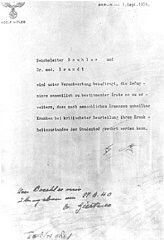
Hartheim castle, a euthanasia killing center where people with physical and mental disabilities were killed by gassing and lethal injection. Hartheim, Austria, date uncertain.
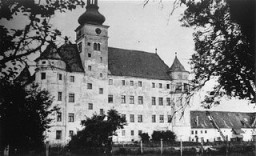
Buses used to transport patients from the Eichberg hospital near Wiesbaden to Hadamar euthanasia center. The windows were painted to prevent people from seeing those inside. Germany, between May and September 1941.

This photo originates from a film produced by the Reich Propaganda Ministry. It shows two doctors in a ward in an unidentified asylum. The existence of the patients in the ward is described as "life only as a burden." Such propaganda images were intended to develop public sympathy for the Euthanasia Program.
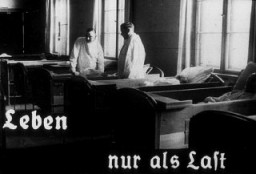
This image originates from a film produced by the Reich Propaganda Ministry. It shows patients in an unidentified asylum. Their existence is described as "life without hope." The Nazis sought, through propaganda, to develop public sympathy for the Euthanasia Program.
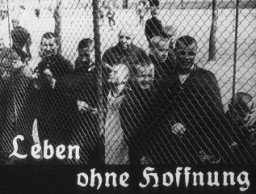
Slide to indoctrinate youth taken from a Nazi propaganda filmstrip. Promoting "euthanasia," it was prepared for the Hitler Youth. The caption says: "Mentally ill Negro (English) 16 years in an institution costing 35,000 RM [Reichsmarks]." Place and date uncertain.
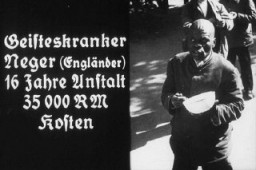
This image originates from a film produced by the Reich Propaganda Ministry. It is captioned: "A moral and religious conception of life demands the prevention of hereditarily ill offspring." Nazi propaganda aimed to create public support for the compulsory sterilization effort.
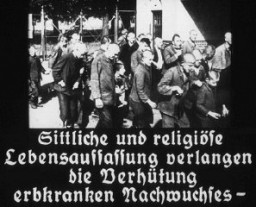
Kaufbeuren euthanasia facility. Killings by lethal injection took place in Kaufbeuren. Germany, 1945.
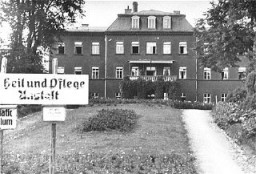
Head nurse of the children's ward at the Kaufbeuren-Irsee euthanasia facility. Kaufbeuren, Germany, 1945.
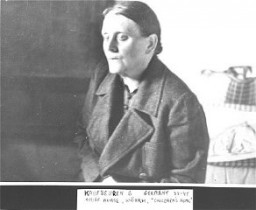
Smoke rising from the chimney at Hadamar, one of six facilities which carried out the Nazis' Euthanasia Program. Hadamar, Germany, probably 1941. [Dioezesanarchiv Limburg (DAL), Papers of Father Hans Becker]
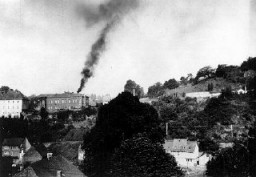
Personnel of T4, the agency created to administer the Nazi Euthanasia Program. Pictured from left to right are: Erich Bauer (chauffeur), Dr. Rudolf Lonauer, Dr. Victor Ratka, Dr. Friedrich Mennecke, Dr. Paul Nitsche,and Dr. Gerhard Wischer. Berlin, Germany, 1939–45.
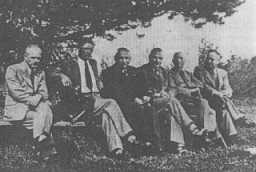
Friedrich Mennecke, a Euthanasia Program physician who was responsible for sending many patients to be gassed. He was sentenced to death in 1946. Germany, date uncertain.
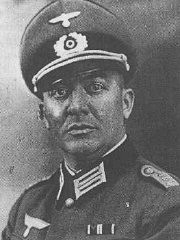
Nazi physician Karl Brandt, director of the Euthanasia Program. August 27, 1942.
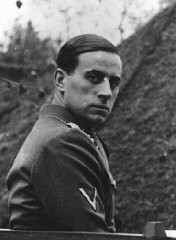
Cemetery at Hadamar. This photograph was taken toward the end of the war. Hadamar, Germany, April 1945.
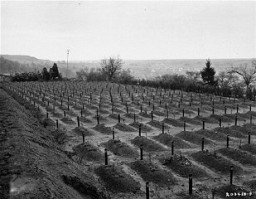
Portrait of Herschel Grynszpan taken after his arrest by French authorities for the assassination of German diplomat Ernst vom Rath. Grynszpan (1921-1943?). Born in Hannover, Germany, was the son of Polish Jews who had immigrated to Germany. In 1936 Grynszpan fled to Paris. On November 7, 1938, after having learned of the expulsion of his parents from Germany to Zbaszyn the Polish frontier, Grynszpan assassinated Ernst vom Rath, the third secretary of the German embassy in Paris. The diplomat's…
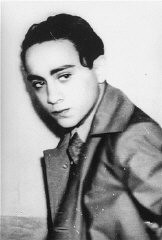
Gerd Zwienicki studies outside the Würzburg Jewish teachers seminary shortly before it was closed down on Kristallnacht. Würzburg, Germany, 1938.
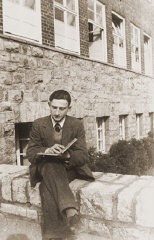
Storefronts of Jewish-owned businesses damaged during the Kristallnacht ("Night of Broken Glass") pogrom. Berlin, Germany, November 10, 1938.

As the synagogue in Oberramstadt burns during Kristallnacht (the "Night of Broken Glass"), firefighters instead save a nearby house. Local residents watch as the synagogue is destroyed. Oberramstadt, Germany, November 9-10, 1938.
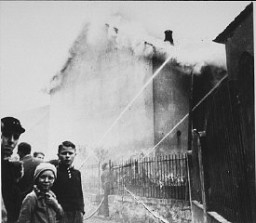
The Boerneplatz synagogue in flames during the Kristallnacht pogrom (the "Night of Broken Glass"). Frankfurt am Main, Germany, November 10, 1938.

Local residents watch the burning of the ceremonial hall at the Jewish cemetery in Graz during Kristallnacht (the "Night of Broken Glass"). Graz, Austria, November 9–10, 1938.
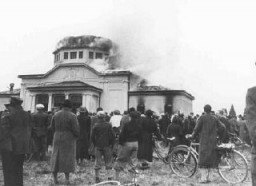
The Neue Weltgasse synagogue burns during the Kristallnacht ("Night of Broken Glass") pogrom. Vienna, Austria, November 9, 1938.
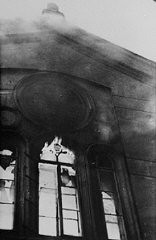
We would like to thank Crown Family Philanthropies, Abe and Ida Cooper Foundation, the Claims Conference, EVZ, and BMF for supporting the ongoing work to create content and resources for the Holocaust Encyclopedia. View the list of donor acknowledgement.